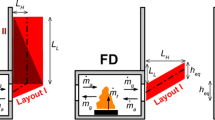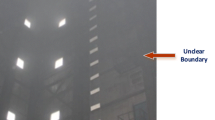Abstract
Scaling laws based on the conservation of the Froude number have been widely used in both fire research and fire engineering design in tunnels. However, the applicability of scaling laws in tunnel fires with natural ventilation has not been systematically verified. In order to verify the scaling laws for tunnel fires with natural ventilation, two model tunnels were tested: Tunnel-L, measuring 20 m long, 0.9 m wide and 0.46 m high, representing the prototype tunnel, and Tunnel-S, measuring 10 m long, 0.45 m wide and 0.23 m high, representing a ½-reduced-scale tunnel. Both tunnels were made of material with a very low heat transfer coefficient, thus heat loss at the boundaries was negligible. The first series of fire tests, with heat release rates of 15.8 kW, 31.6 kW and 63.2 kW, was conducted in Tunnel-L and the second series of fire tests, with heat release rates of 2.8 kW, 5.6 kW and 11.2 kW, was conducted in Tunnel-S. The experimental results showed that compared to the physically measured data in Tunnel-L, the data deduced from Tunnel-S based on scaling laws could lead to a significant under-estimation of the peak temperature rises along the tunnel with errors as high as 50 ~ 70%, except those above the fire sources, and a remarkable over-estimation of smoke concentrations. The study demonstrated that scaling laws could be invalid for tunnel fires with natural ventilation and that results measured in reduced-scale tunnels should be further verified when applied to full-scale prototypes.



















Similar content being viewed by others
References
Kile GW, Gonzalez JA (1997) The memorial tunnel fire ventilation test program: the longitudinal and natural tests. J Ashrae Trans 103:701–713
Studiensgesellschaft Stahlanwendung e. V. (1995) Fires in transport tunnels: Report on full-scale tests. Eureka Project EU499 FIRETUN, Düsseldorf, Germany
Ingason H, Li YZ, Loennermark A (2015) Runehamar tunnel fire tests. Fire Saf J 71:134–149
Simcox S, Wilkes NS, Jones IP (1988) Fire at King's cross underground station, 18th November 1987: Numerical solution of the buoyant flow and heat transfer. Report no. AERE-G 4677, Harwell Laboratory, Harwell, UK
Williams FA (1969) Fire research abstracts and reviews, 11:1–20
Quintiere JG (1989) Scaling applications in fire research. Fire Saf J 15:3–29
Thomas PH (2000) Dimensional analysis: a magic art in fire research. Fire Saf J 34:111–141
Yao X, Marshall AW (2006) Quantitative salt-water modeling of fire-induced flow. Fire Saf J 41:497–508
Roh JS, Yang SS, Ryou HS, Yoon MO, Jeong YT (2008) An experimental study on the effect of ventilation velocity on burning rate in tunnel fires—heptane pool fire case. J Build Environ 43:1225–1231
Lee SR, Ryou HS (2005) An experimental study of the effect of the aspect ratio on the critical velocity in longitudinal ventilation tunnel fires. Fire Saf J 23:119–138
Yao Y, He K, Peng M, Shi L, Cheng X, Zhang H (2018) Maximum gas temperature rise beneath the ceiling in a portals-sealed tunnel fire. Tunn Undergr Space Technol 80:10–15
Wu Y, Bakar MZA (2000) Control of smoke flow in tunnel fires using longitudinal ventilation systems—a study of the critical velocity. Fire Saf J 35:363–390
Li YZ, Ingason H (2013) Model scale tunnel fire tests with automatic sprinkler. Fire Saf J 61:298–313
Ingason H (2007) Model scale railcar fire tests. Fire Saf J 42:271–282
Hansen R, Ingason H (2012) Heat release rates of multiple objects at varying distances. Fire Saf J 52:1–10
Choi BI, Oh CB, Kim MB, Han YS, Choi JS (2006) A new design criterion of fire ventilation for transversely ventilated tunnels. Tunn Undergr Space Technol 21:277–278
Wang Y, Jiang J, Zhu D (2009) Full-scale experiment research and theoretical study for fires in tunnels with roof openings. Fire Saf J 44:339–348
Yan T, Shi MH, Gong YF, He JP (2009) Full-scale experimental study on smoke flow in natural ventilation road tunnel fires with shafts. Tunn Undergr Space Technol 24:627–633
Chang L, Zhong M, Shi C, Zhang P, Tian X (2016) Temperature profile of fire-induced smoke in node area of a full-scale mine shaft tunnel under natural ventilation. J Appl Therm Eng 110:382–389
Oka Y, Oka H (2016) Velocity and temperature attenuation of a ceiling-jet along a horizontal tunnel with a flat ceiling and natural ventilation. J Tunn Undergr Space Technol Inc Trenchless Technol Res 56:79–89
Oka Y, Imazeki O (2015) Temperature distribution within a ceiling jet propagating in an inclined flat-ceilinged tunnel with natural ventilation. Fire Saf J 71:20–33
Guo Q, Zhu H, Yan Z, Zhang Y, Huang T (2019) Experimental studies on the gas temperature and smoke back-layering length of fires in a shallow urban road tunnel with large cross-sectional vertical shafts. Tunn Undergr Space Technol 83:565–576
Ji J, Gao ZH, Fan CG, Zhong W, Sun JH (2012) A study of the effect of plug-holing and boundary layer separation on natural ventilation with vertical shaft in urban road tunnel fires. J Int J Heat Mass Transf 55:6032–6041
Chow WK, Wong KY, Chung WY (2010) Longitudinal ventilation for smoke control in a tilted Tunnel-Sy scale modeling. Tunn Undergr Space Technol 25:122–128
Chow WK, Gao Y, Zou JF, Liu QK, Chow CL, Miao L (2018) Numerical studies on thermally-induced air flow in sloping tunnels with experimental scale modelling justifications. Fire Technol 54:867–892
Kashef A, Yuan Z, Bo L (2013) Ceiling temperature distribution and smoke diffusion in tunnel fires with natural ventilation. Fire Saf J 62:249–255
Fan CG, Ji J, Gao ZH, Han JY, Sun JH (2013) Experimental study of air entrainment mode with natural ventilation using shafts in road tunnel fires. J Int J Heat Mass Transf 56:750–757
Emori RI, Saito K (1979) Model rules on motion of smoke and gases in building fires. Bull Japan Assoc Fire Sci Eng 29(2):41–49
Vauquelin O, Michaux G, Lucchesi C (2009) Scaling laws for a buoyant release used to simulate fire-induced smoke in laboratory experiments. Fire Saf J 44:665–667
Tilley N, Rauwoens P, Fauconnier D, Merci B (2013) On the extrapolation of CFD results for smoke and heat control in reduced-scale set-ups to full scale: atrium configuration. Fire Saf J 59:160–165
Ingason H, Li YZ, Lönnermark A (2015) Tunnel fire dynamics. Springer, New York
Hurley MJ (2015) SFPE handbook of fire protection engineering. Springer, New York
Memorial Tunnel Fire Ventilation Test Program—Test report (1995) Massachusetts highway department and federal highway administration, Massachusetts
Hu LH, Huo R, Chow WK, Wang HB, Yang RX (2004) Decay of buoyant smoke layer temperature along the longitudinal direction in tunnel fires. J J Appl Fire Sci 13:53–77
Alpert RL (1975) Turbulent ceiling-jet induced by large-scale fires. J Combust Sci Technol 11:197–213
Hu LH, Huo R, Li YZ, Wang HB, Chow WK (2005) Full-scale burning tests on studying smoke temperature and velocity along a corridor. Tunn Undergr Space Technol 20:223–229
Emori RI, Saito K (1983) A study of scaling laws in pool and crib fires. Combust Sci Technol 31(5–6):217–231
Li YZ, Hertzberg T (2015) Scaling of internal wall temperatures in enclosure fires. J Fire Sci 33(2):113–141
Acknowledgements
The authors greatly appreciated the comment and review from Dr. Haejun Park affiliated with Oklahoma State University (USA) who significantly improve the quality of the manuscript as well as the financial support from National Natural Science Foundation of China (No. 71974161).
Author information
Authors and Affiliations
Corresponding author
Additional information
Publisher's Note
Springer Nature remains neutral with regard to jurisdictional claims in published maps and institutional affiliations.
Rights and permissions
About this article
Cite this article
Lin, P., Xiong, YY., Zuo, C. et al. Verification of Similarity of Scaling Laws in Tunnel Fires with Natural Ventilation. Fire Technol 57, 1611–1635 (2021). https://doi.org/10.1007/s10694-020-01084-9
Received:
Accepted:
Published:
Issue Date:
DOI: https://doi.org/10.1007/s10694-020-01084-9




